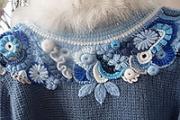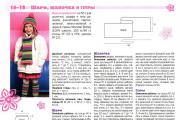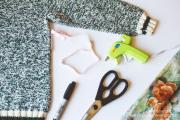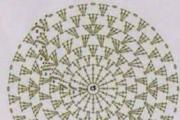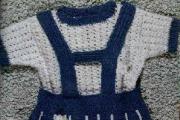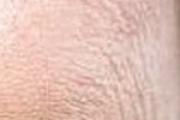Bead embroidery on felt brooch patterns. Embroidered brooch - the most interesting thing in blogs
A brooch embroidered with beads is an elegant and stylish accessory. It's not difficult to make such a brooch with your own hands. The brooch can be worn on the lapel of a jacket, on a jumper, or on a blouse. This accessory can be used to fasten a scarf or shawl. Brooches are used to decorate hats, belts, hair, and bags. To make an original decoration, you do not need to be a skilled needlewoman. Beads and rhinestones will help us in our work. Beads are multi-colored beads with tiny holes. Rhinestones are artificial stones. Sewing beads is not difficult. Gluing or sewing rhinestones onto a fabric or product is also a simple job.
According to the method of gluing, rhinestones are divided into sew-on, hotfix, and rhinestones that are attached using special glue. Hotfix is a rhinestone with glue pre-applied on its metalized bottom, which melts when heated. It's very convenient. Using a candle and tweezers, you can quickly glue the rhinestones to the desired place. You can do this with an iron. A type of rhinestones is rhinestones in tacs: these crystals are fixed in a frame, which, as a rule, is sewn on.
Brooch Black Moth
To work you need:
- Large black rhinestone in the DAC.
- 6 small sew-on rhinestones, preferably in a dac.
- 6 pieces of black glass beads.
- Beads number 10 black, gold, purple, green.
- Bead cutting chameleon.
- Felt or base for bead embroidery.
- Mustache wire.
- A piece of leather.
- Cardboard.
- Brooch clasp.
- Embroidery needle.
- Paper, pencil.
- Scissors.
- Glue Moment.

Draw a picture on paper. Cut. Transfer the pattern to the embroidery base. Trace the outline of the moth. Sew the largest rhinestone in the DAC in the center.


Embroider the veins with small gold beads. Sew starting from the top edge. Sew the first row close to the outer contour. At the bottom we sew bugles and a small rhinestone.
After this we embroider with golden beads. To make it easier to embroider the veins, draw lines with a pencil.

Fill the remaining space with beads. We sew green and purple beads along the veins.

After we have finished the embroidery, cut it along the contour. We cut carefully so as not to touch the bead thread. We make moth antennae from wire. Sew the antennae on the wrong side. Next, cut out the outline of the moth from cardboard and glue it to the back.

Take a piece of leather and determine where the fastener will be. Make slits and insert our fastener. Glue the skin to the cardboard, trim off the excess. Trim the edge with black beads according to the diagram:

The black moth brooch is ready.
According to the author. Probably, many people like to collect autumn leaves, because they so want to keep a piece of colorful autumn at home. But the leaves quickly dry out, darken and crumble. Therefore, I suggest you create a wonderful, soulful, warm thing, and most importantly durable - a brooch in the shape of an autumn oak leaf.
Tools and materials:
Thin fabric, ideally organza, I have linen and cotton;
Thin wire;
Embroidery threads in several shades, this time I chose wool embroidery threads;
Embroidery needle;
Scissors;
Pencil;
Brooch pin.
Let's begin!
First we need a sheet stencil. You can download it from the Internet or draw it yourself.
You can do it this way: we pick up a leaf of a suitable size and shape on the street (I have a small one 6.5 x 3.5 cm), bring it home, put it under a sheet of paper and shade the surface with a pencil. All contours and veins are drawn on paper.
Now you can cut out the leaf and the stencil is ready!
We select threads. I have wool for embroidery in 3 shades (green, ocher and light sand).
If you are a complete beginner, use only 2 shades of orange - the leaf will still turn out beautiful!
We take the hoop and stretch the fabric very well in it - like a drum.
We trace the stencil onto the fabric with a pencil; you can use a white gel pen, unless of course the fabric is white.
Along the edge of the sheet we show the direction of the stitches with small strokes (photo on the right).
To make the future brooch more rigid, at this stage you can glue the fabric with non-woven material. To do this, cut out a piece of non-woven fabric using a stencil, make it a couple of millimeters smaller than the leaf itself and use an iron to glue it inside the outline. Then draw the veins with the direction of the stitches along the non-woven fabric.
Take a piece of wire larger than the length of the leaf outline (0.2 mm wire is a bit thin, it’s better to take a thicker one). We fold the tails of the wire together and bring them out on the wrong side at the base of the sheet. We take a thread of the same tone that will be used to embroider the edge of the sheet (I use ocher thread) and begin to grab the wire according to the shape of the leaf with small stitches, moving along the contour of the sheet from left to right.
The wire is sewn. The photo on the right is the wrong side.
Let's start embroidering. When doing voluminous embroidery, they always move from left to right. We turn our sheet upside down, it will be more convenient. We fasten the thread without a knot at the base of the sheet (explanation and photo below) and begin to sew the outline with a buttonhole stitch (photo on the right). We place the stitches very tightly so that the wire is not visible, we make them of different lengths, and do not forget about the direction of the stitches.
I completely forgot about securing the thread. Our leaf should be double-sided, so we fasten the thread without a knot. To do this, we make 2 stitches “forward with the needle”, go back and pierce the thread through, bringing the needle inside out, and tighten. It’s better to do it from the wrong side, at least it seems more convenient to me. When the thread runs out, we secure it in a similar way: we sew through the last stitch, and then we hide the thread under the stitches, cutting off the tip so that it does not stick out.
Here you can alternate colors as you please. But I will tell you how I did it.
We add more greenery and paint a little ocher around the edge.
Let's move on to the other half. The embroidery should now be turned over.
We stitch almost a whole row with ocher thread, ending a little short of the top of the sheet.
We sew up the entire remaining space of the second half with light sand thread.
Add more greenery to both halves of the leaf. We place the stitches on top of the already embroidered ones, this way the embroidery is well compacted and the gaps, if any, are filled.
Add more ocher and embroider the central vein with a stem stitch (see stitch). There is no need to make a vein on the reverse side; a pin will be attached there.
Now you can very carefully cut out the leaf. We take sharp scissors and cut the fabric as close to the outline of the sheet as possible (you don’t have to remove it from the hoop, it’s even more convenient). To avoid accidentally cutting the wire, bend it under the sheet.
After cutting, a small fringe remains, we trim it. If you accidentally touch the threads while cutting, glue them with a drop of fabric glue.
After trimming, the threads are almost invisible. Ideally, of course, you should use organza for embroidery; it is transparent and the edge turns out perfect.
All that remains is to form the petiole. We bend the wire, leaving the length we need, twist it and cut it at the very base of the sheet, trying to hide the ends.
Using a needle, we pull a small piece of ocher thread through the base of the sheet; you can make a few stitches to hide the ends of the wire.

Bead is a project dedicated to beads and beadwork. Our users are beginner beaders who need tips and support, and experienced beaders who cannot imagine their lives without creativity. The community will be useful to anyone who, in a bead shop, has an irresistible desire to spend their entire salary on bags of coveted beads, rhinestones, beautiful stones and Swarovski components.
We will teach you how to weave very simple jewelry and help you understand the intricacies of creating real masterpieces. Here you will find diagrams, master classes, video tutorials, and you can also directly ask advice from famous bead artists.
Do you know how to create beautiful things from beads, beads and stones, and do you have a solid school of students? Yesterday you bought your first bag of beads, and now you want to weave a bauble? Or maybe you are the head of a reputable printed publication dedicated to beads? We need you all!
Write, tell us about yourself and your works, comment on posts, express your opinion, share techniques and tricks when creating your next masterpiece, exchange impressions. Together we will find answers to any questions related to beads and bead art.
Today, handmade items are in trend, from decorative items for the home to sweet products. The cost of such products is quite high, but with a little perseverance and minor material investments, you can do something similar yourself. In this article we will dwell in detail on beadwork, namely on brooches embroidered with beads with our own hands. Let's consider the necessary materials and tools. Let's learn how to make a brooch from beads on felt, a master class will help us with this.
Required materials and tools
The set of tools may vary depending on the type of product. In the future, each master will have his own preferences and tricks, but we will look at the basic tools and schemes.
Tools


- natural. They have a wide color palette, they are soft and tactilely pleasant. There are also disadvantages - low strength, they tear quickly, they rot in high humidity (after treatment with beeswax this disadvantage will be eliminated);
- synthetic from polyamide and lavsan. Their advantages are high strength, resistance to external factors, low shrinkage, high durability and sliding ability, and do not get tangled. But such threads can cause allergic reactions due to chemicals;
- reinforced from a lavsan core, braided with a second thread. They have high strength, elasticity, wear resistance, and resistance to external factors. Disadvantages include high cost and inclusions of chemical elements that can cause allergies.
In addition to the material, it is important to consider the thickness of the thread. Sometimes threads can be replaced with fishing line or monofilament.
- Scissors.
Materials for work
To make a beautiful brooch, you will need:
This is our base for embroidery. This material is based on wool fiber. Happens:
- natural – quite durable, susceptible to coloring. It repels dirt and is hypoallergenic. It has a high cost and increased ability to deform;
- wool blend - often the ratio of wool to viscose is 60:40. It is not inferior to natural in properties, but for small parts, for example, for a brooch, it is completely unsuitable, because... the product will lose its shape;
- artificial - acrylic or eco-felt. Washable, retains its shape, dyes well, does not fade, hard, not elastic;
- with bamboo fibers and viscose - hard, durable, easy to color, pleasant to the body, but loses its shape.

Beads
These are small beads of various shapes. When choosing the type of beads, it is better to stop at one, so that the pattern does not seem blurred, uneven, or individual beads do not get knocked out.
Quality control points are uniformity (the size and shape of the beads do not differ from each other) and do not stain when exposed to water.

Types of beads can be divided depending on the country of origin:
- Chinese - small, beads are not the same. Therefore, to create a brooch with beads on felt, it is better not to use them, since you will have to spend a lot of time and consumables to obtain the design;
- Czech. Beads with clear and even edges. It is very popular. Please note: color shades vary from batch to batch, and there are also defective beads. Czech beads are in the middle price category;
- Japanese is one of the highest quality: matching colors, shape, size, weight, but the price is an indicator of this;

Japanese Miyuki beads

Japanese Delica beads

Czech beads

Chinese beads
- Taiwanese or Indian. It cannot be classified as quality. It is very brittle, heterogeneous, there are sharp edges, a narrow range of colors, the paint is unstable;
- Indian - has all the characteristics of Taiwanese.
Each country has its own size classification system, so it is important to take these features into account.
According to the form they are distinguished:
- beads – round shape with a round or square hole, melted edges;
- cutting – short cylindrical shape (about 2 mm);
- glass beads – cylindrical shape (3-25 mm), rounded, faceted, twisted edges.

Round beads


Bugle beads
Size classification: 6.0 – 15.0. How to understand the marking: it is assumed that 1 inch (which is 2.54 cm) contains the number of beads stated on the marking. For example, 15/0 – 15 pcs. beads will fit in one row of 2.54 cm.
In addition, it also depends on the number:
- hole diameter;
- number of beads in 1 g.

There is no single measurement system; sometimes books on handicrafts have their own marking method.
- Genuine leather - for the back of the brooch.
- Beads have a smooth spherical shape. In a brooch they are used to highlight part of the picture and add volume. Beads can be natural, artificial and semi-precious.
- Stamens are an additional element for creating flowers (like the core), as a decoration.
- Ribbons are an additional element of brooch decor, useful for finishing the edges and adding volume. There are different types of material (silk, satin, cotton).
Where to start and how to choose the most effective combination of materials
First you need to decide on the type of decoration. It could be an insect, a flower, an animal, or part of a plant. Based on this, a weaving pattern is selected. As a rule, the master class knows what materials you will need. But you can change them at your discretion.
At the preparatory stage you need:
- choose the type of product (shape, size, purpose) - for beginners it is better to practice on simple flowers and butterflies. Before choosing the type of brooch, think about what you will wear it with and where to attach it. A funny bug, fruit or bee is suitable for a summer outfit or a spring jacket. For an autumn coat or knitted sweater - a voluminous, large sheet, not very colorful;
- select materials and their compatibility. A brooch can be made from budget materials (plastic beads, Chinese beads, plain felt), or you can weave a real jewel. Of course, for this you will need silver-plated beads, semi-precious or crystal stones, rhinestones and beads. But you must admit that the appearance of such a product will be much more representative and impressive.
- practice stringing beads and evaluate how smoothly the pattern lies and whether the tools are convenient.
Brooches made of beads and felt and their patterns
After preparing the necessary equipment, you can begin step-by-step master classes. There is no one universal pattern for any type of brooch, so we suggest focusing on the most famous ones.
Bead embroidery on felt - “Watermelon” brooch pattern, master class


Separate each internal segment with color shades, creating the outline of a watermelon using more saturated colors. 
- If you need to replace the thread, or if it runs out:
- do not use the thread completely, leave it to secure the beads;
- use the remaining thread to secure the last few beads several times;
- Using stitches on the wrong side, bring the thread to the center of the future brooch and secure with a knot;
- Bring a new thread through the middle of the embroidery through the last 3-4 beads.

- We transfer the drawing template onto the cardboard. The new template should be a few millimeters smaller than the embroidered design;

- carefully lubricate the felt with glue, thereby fixing all the nodes and transitions, and glue the cardboard;

- Now glue the pin onto the cardboard. Let the glue dry time;

- on suede or leather (back material) we make holes to the size of a pin;

- lightly lubricate the pin with glue to secure it;

- cut off unnecessary parts of suede (leather);

- sew the felt and backing material together. We make a knot on the wrong side, stringing beads, passing any processing seam along the edges.









Embroidery from felt and beads, “Butterfly” brooch pattern and master class

Some stages will be similar or repeated, so we will not dwell on them in detail.

(Click on the picture to expand it to full size)

Beaded brooch on felt “Cat, cat”
There are many variations of patterns for cats and cats; let’s consider a more complex type of pattern – the Siamese cat. The difficulty is this: in order for the brooch to match the species characteristics of the animal, it is necessary to observe the transition of the characteristic color of the coat. Before you begin, carefully study and think about which beads and which shades will be best combined and not merge.





















Please note that the technique of embroidering brooches on felt with beads is the same, just set the specifics first. For example:



Beads make beautiful not only brooches, but also necklaces, belts, collars, the latter are especially gaining popularity and are in trend.
Video Lessons
Additional SCHEMESbrooches and pendants
Dear master, if you are passionate about creating embroidered pendants and brooches, then this set is perfect for you! With it, you can create a variety of compositions for any occasion. We drew them ourselves, so they are 100% original and appropriate for the lesson. You can use them for any purpose, including commercial.

Indicate your Name and your email where to send a set of diagrams
Simple expert advice will help you create a masterpiece. Just listen to them:
- Pay attention to the size of the beads.
- Czech-made beads are more common on the market. It's inexpensive and good.
- When attaching a pin to the skin, pre-mark the insertion locations.
- When making cuts or holes for inserting a pin, let them be slightly smaller than necessary.
- It is better to sew beads on non-slip fabric, and felt is an ideal option.
- Use organizers or small containers to store beads. In such containers, the beads are calibrated by color and size (which reduces the time when embroidering), if this is not the case, pour small portions of beads onto a napkin.
- Collect beads with a needle.
- At first, it is better for beginners to use ready-made diagrams, gradually include one new element at a time and not deviate from the step-by-step instructions.
- If it is difficult to insert the thread into the eye of the needle, then you can use the end of the thread:
- dip in colorless varnish, dry, press down with fingers;
- With your fingers, press the end of the thread to the candle and pull it through;
- Use a lighter to slightly burn the end of the thread.
- It is better to start with schemes that include no more than 5-6 color shades.
- The process should not affect health, so use a lamp, magnifying glass, place materials and tools conveniently and nearby. Do not hold the product too close or too far from you.
- Do not experiment with new ways of attaching beads to a product; make practice stitches on a separate material.
- Don't limit yourself to one seam, learn new techniques. You will only benefit from this product.
Thus, despite the many nuances and features of embroidering brooches with felt beads, this type of handmade work should not cause any great difficulties. The main thing is to clearly define the design and purpose of the product.


